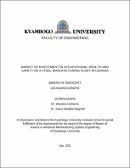| dc.description.abstract | The subject of health and safety of workers in the steel manufacturing sector has become a concern of recent mainly in developing countries. The study therefore sought to investigate the impact of investment in health and safety on steel manufacturing companies in Uganda, a case study of Roofings Rolling Mills in Namanve Industrial area. The aim of the study was to identify the different health and safety preventive measures that have been put in place, examine the costs associated with OHS measures and work-related incidents, determine the qualitative and quantitative benefits of the OHS intervention measures and finally find out how health and safety affect the employee’s productivity using regression analysis. A descriptive survey study was adopted as the research design. Review of incident cases registers, hazard identification and risk assessments forms, employee compensation claims, records for lost workdays was done. Simple random and judgmental sampling techniques were used to select subjects from each plant to give data on how health and safety affect the productivity measures of quality, work output, attendance and one’s morale. The data on productivity measures, accident prevention costs, accident costs was analyzed both qualitatively and quantitatively using the IBM SPSS VESION 26 and Microsoft excel. The findings of this study show remarkable reductions in injury numbers, lost workdays, and this translates into low injury costs and this is linked to be direct benefits of occupational safety and health measures. For every one percent increase in OHS measures, the benefit in terms of reduction in direct injury costs is between 2 to 8 percent and this was consistent with other studies. From the coefficient estimates of regression analysis, both work quality and quantity increase by 76.6 percent, the morale of employee increases by 76.7 percent while the attendance improves by 76.2 percent. The marginal increments in the productivity measures due to a unit increase in safety are; 27.6 percent for one’s presence, 28.2 percent for work quality, 28.3 percent for individual’s work output and 26.8 percent for one’s morale. The coefficient of determination (R square) is 0.49 which shows that productivity is 49 percent influenced by the health, safety and the rest 51 percent is explained by other factors which were not considered in the study.
The findings help the employer not to look at the expenditure associated with OHS measures as a cost but rather as an investment with return and not to make decisions on whether any changes will bring cost saving but whether it will protect workers. The findings will help the organization to reduce the levels of risk at different plants. | en_US |

